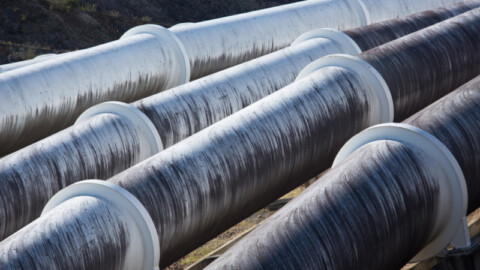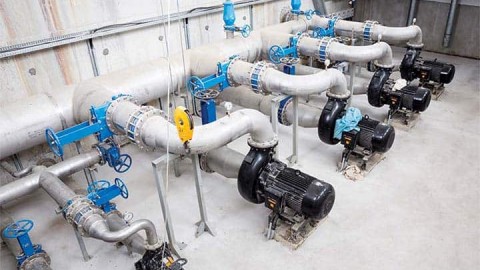The PIA’s Australian Pump Technical Handbook is a cornerstone text for the Australian pump industry and, in our opinion, a must have for anyone who deals with pumps on a regular basis. In this ongoing series, we feature abridged chapters from the classic book to showcase the various areas covered and to reacquaint readers with the technical aspects of pumps. Here, we take a close look at intake design.
It is important that the intake of a pump station is designed correctly. This first part discusses potential problems that can occur and how they can be observed and what are their consequences. An unsatisfactory hydraulic design of an intake or sump can have far-reaching implications on the overall performance of a pumping station.
The fluids under consideration are water and air, the water being pumped and the air being above the free surface or, in some cases, being entrained in the water. However, the results will apply in principle to other fluids used in process industries as long as allowance is made for effects arising from the difference in the fluid properties. Viscosity and density are the most important properties to be considered.
Poor hydraulic design of a pump sump and intake could arise because of insufficient consideration at the design stage or because of site constraints. A summary of the possible consequences is as follows.
Air gulping
With water level at or only just above the top of the intake there will be a tendency for the air to be drawn into the intake either continuously or intermittently in the form of gulps. There may be a distinct local depression in the water surface adjacent to the intake, described as “drawdown”, which may accentuate the problem.
High intake velocities will also cause increased air flow rates into the intake. The basic reason for this condition is that the sump water level is too low with not enough cover above the intake.
In extreme cases the pump may lose prime and the delivery will fall to zero. If the pump does continue to deliver water, it will also discharge large quantities of air, which may cause serious problems in the system. For example, the pump may be supplying cooling water to a condenser where air would cause overheating of the tubes.
Large quantities of air passing through a pump impeller may cause uneven loading resulting in vibration, rough running and possible damage to the bearings in a fairly short time. Although there is not much published data on changes in performance due to air entrainment, it is known that air in quite small quantities can lead to a reduction in discharge and loss in efficiency.
In a typical case, a centrifugal pump with three per cent free air showed a drop in efficiency of 1.5 per cent; however, actual figures depend very much on the type of pump (axial flow pumps being more sensitive to entrained air than centrifugal pumps). Normal design practice should be to exclude all air. This implies that there should be no air entraining vortices at the intake and that there should be no air entrained in the approach flow to the intake due to other causes.
Aerated
Air bubbles may exist in the water of a sump for a variety of reasons, but they are usually due to a falling water jet as the water enters the sump from a weir or culvert that is above the sump water level. If there is insufficient time for air bubbles to rise to the water surface before they are carried close to the intake section, they will enter the intake and be carried into the pump.
It is best to avoid high level entry into the sump, but if this is not possible, then, sufficient separation should be provided from the source of aeration at the intake to allow the air bubbles to rise to the surface of the water in the sump. Approximate calculations based on the mean horizontal velocity in the sump, the minimum rise velocity of the air bubbles and water depth in the sump, can be used to determine the separation distance.
A typical minimum figure for the rise velocity is 0.2m/s based on air bubbles between 2–5mm diametre. Obviously, larger bubbles will rise faster and so reach the water surface before the smaller bubbles. However there is an important class of intake used for sewerage where this procedure cannot always be used and so some air entrainment into the pump may have to be accepted. Similar to that for air gulping above, the severity depends on the quantity of air and type of pump.
Air entraining vortices
The extreme case of a steady vortex with an air core between the water surface and the intake feeds air directly into the pump. In less severe cases, the air may enter only intermittently with the vortex being unsteady and less developed. Even if no air is drawn in, the swirling flow associated with the surface can cause problems.
Asymmetry or pre-rotation in the flow approaching an intake coupled with stagnant regions of water above or near the intake, increase the chances of air-entraining vortices forming. Similar to that for air gulping above, the severity depends on the quantity of air and the pump type. There are also effects similar to submerged vortices and swirling flow below, the severity depending on the vortex strength and the pump type.
Submerged vortices
These vortices originate from the side walls and the floor of the sump rather than the water surface. In modelling, the vortex core can be seen by injecting dye into the water near where a vortex is anticipated. Sometimes the vortex may be visible as small air bubbles in the water that are centrifuged into the core.
There is also the possibility that air in the solution can be released by the very low pressure in the rapidly rotating core. There is not a great deal known about the origin of submerged vortices except that they probably stem from swirl in the approach flow and vortices in the boundary layers on the sump floor and sides. The presence of a submerged vortex core indicates that there is appreciable swirl in the well.
Rapid changes in local pressure in the pump impeller as a vortex core is ingested can cause severe vibration and cavitation. Axial flow pumps are generally more susceptible to damage from vortices than other types of pumps.
Swirling flow
Swirling flow is usually caused by large scale rotation in the bulk of the fluid in the sump which is then amplified as the flow converges into the intake. In many cases the swirl may be accompanied by a rapidly rotating inner core even if there is no surface vortex visible.
Severe swirling flow is the same as for submerged vortices above, but there is an additional effect, when the swirl is on a larger and less intense scale but is centred on the pump axis. In this case, there can be a gain or reduction in the pump performance depending on the relative directions of the swirl and pump impeller. This effect is most noticeable in axial flow and mixed flow pumps.
Large scale turbulence
In this case the eddy size is the same order of magnitude as the intakes cross section area. Unsteady flow patterns arising from obstructions in the sump or poor inlet conditions into the sump are the primary cause. Vortex shedding from pillars or other pumps is a common cause. Uneven blade loading, changing with time may cause vibration and noise in the pump.
This effect will be worse when the pump is very close to the intake section as in a vertical suspended wet well installation. If there is a moderate length of conduit between the intake and the pump (say more than 10 diameters) or if there are several bends and changes of cross section, the initial turbulence may not be so important in defining the flow conditions at the pump inlet flange. In this latter case, the flow conditions will be set by the geometry of the pipe work leading to the pump inlet flange.
Distorted velocity profile
This can occur for a variety of reasons but is generally caused by some form of uneven distribution of the flow into the sump. The velocity distribution across the flow in the sump, then shows, for example, a higher value on one side than the other or a higher value at the floor than the surface.
This uneven distribution may be steady in time, but it can be a prime reason for swirl and vortex formation at the intake. The main effect is to promote swirl and vortex formation at the intake section, with the results described in the above sections on submerged vortices and swirling flow.
However, effects similar to that for large scale turbulence above could arise with the pump near the intake section, where the nonuniform velocity distribution could lead to asymmetric loads on the pump impeller.
Although this section discusses flow conditions in the sump, distorted velocity profiles may be caused by bends and changes in sections of the pipe work between the intake section and the pump, if the pump is not sited very close in the intake.
Stagnations
Large areas of water above and behind an intake are almost stationary. The only movement within these stagnant areas is caused by the shear generated across the surface separating them from the main flow into the intake. Some such stagnant regions are unavoidable, but their extent can be reduced by careful design and filling-in with solid materials at the more obvious places.
The boundaries between stagnant regions and the main flow tend to be unstable and fluctuate in position. These regions promote unsteadiness in the main flow and increase the chances of air entraining vortices forming.
Summary
It is important when planning a pump station to avoid creating in the stations any of the problems outlined above. If there is any doubt about the suitability of the pumps in a station, model tests of the system should be undertaken.
















